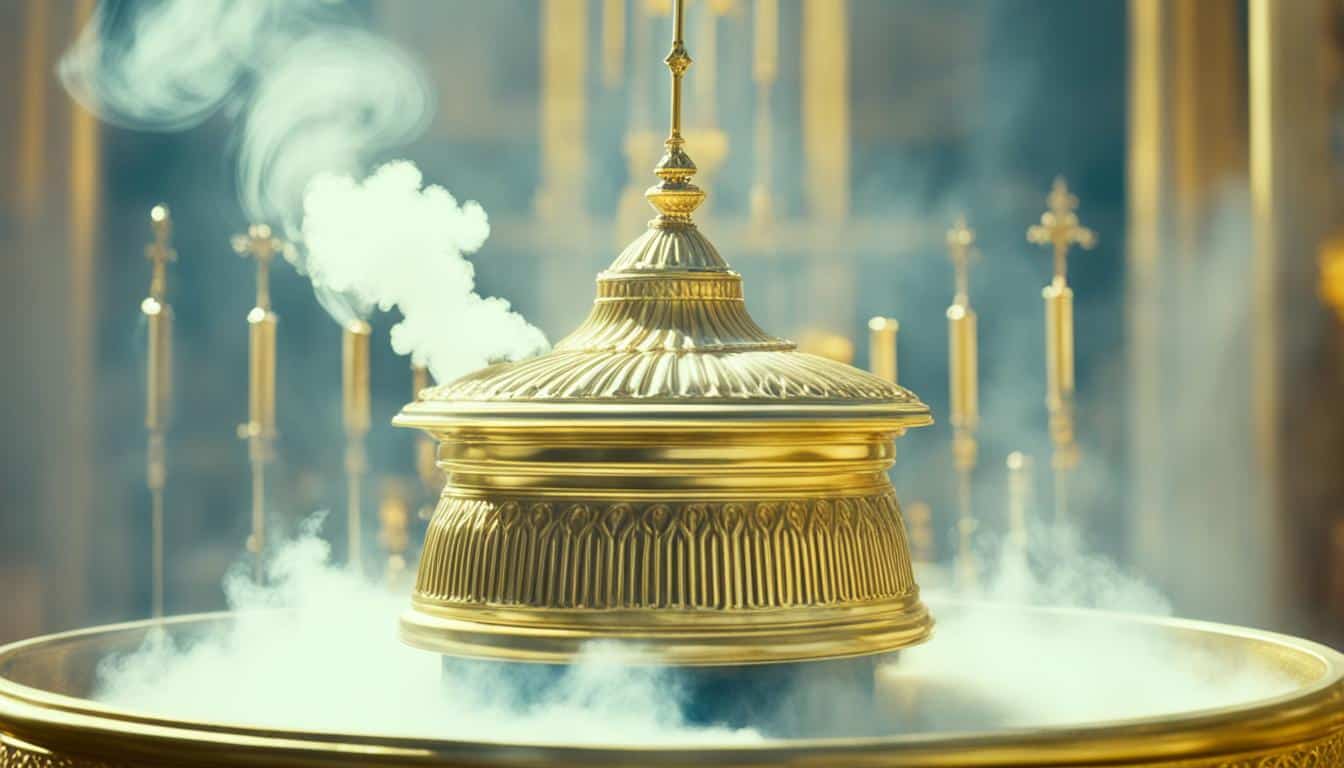Table of Contents
Have you ever wondered about the significance of the tabernacle in the New Testament?
How does it relate to Jesus’s ministry and the spiritual truths of Christianity?
In this article, we will explore 10 references to the tabernacle in the New Testament, uncovering the profound connections between the tabernacle and Jesus’s work. Prepare to be amazed as we delve into the rich symbolism and divine revelations that emerge when these references are examined closely.
Throughout the New Testament, the tabernacle is not just a historical artifact but a powerful symbol that points to Jesus’s role as the ultimate dwelling place of God’s presence among humanity. From the book of Hebrews to the Gospels and Revelation, the tabernacle’s significance is woven into the fabric of the Scriptures.
Join us as we embark on this journey of discovery and uncover the hidden depths of meaning behind the tabernacle’s references in the New Testament. Prepare to have your understanding expanded and your faith deepened as we dive into these timeless truths.
Make Sure You Watch The Video: I would love for you to subscribe to my YouTube channel as well… Thanks in advance!!
The Tabernacle as a Model of the Heavenly Reality (Hebrews 8:5)
In Hebrews 8:5, the priests serve at a sanctuary that is described as a copy and shadow of what is in heaven. This verse reveals that the earthly tabernacle was designed as a model of the heavenly reality, with its rituals and structures pointing beyond themselves to convey deeper spiritual truths.
Throughout the Bible, the tabernacle occupies a central role in conveying the relationship between God and His people. It served as a physical representation of God’s presence among the Israelites, a place where they could worship and offer sacrifices. However, its significance goes beyond its physical form.
Just as the tabernacle was a copy and shadow of the heavenly reality, the rituals performed within its walls were symbolic of greater spiritual truths. Each component of the tabernacle—the altar, the veil, the Ark of the Covenant—carried profound meaning and foreshadowed the redemptive work of Jesus Christ.
The tabernacle’s rituals and structures were designed to point beyond themselves to greater spiritual truths.
For example, the high priest entering the Most Holy Place once a year symbolized the limited access to God’s presence due to sin. The veil separating the Holy Place from the Most Holy Place represented the barrier between God and humanity. The sacrificial system demonstrated the need for atonement and pointed to the ultimate sacrifice of Jesus on the cross.
This beautiful symbolism highlights the spiritual realities that the tabernacle represented. It revealed humanity’s separation from God and the need for a mediator, later fulfilled by Jesus Christ. It emphasized the importance of repentance, forgiveness, and the ultimate redemption found in Christ’s sacrifice.
Through the tabernacle, God provided a visual representation of His plan for salvation and His desire to dwell among His people. It showcased His holiness, grace, and love, as well as His desire for a restored relationship with humanity.
The Superior Ministry of Jesus and the Tabernacle (Hebrews 9:1-11)
The letter to the Hebrews provides a detailed comparison between the tabernacle and its services and the superior ministry of Jesus. This comparison sheds light on how Jesus, through his ministry, surpasses the functions and offerings of the tabernacle, ultimately appearing in God’s presence on our behalf.
In Hebrews 9:1-11, the author explains the intricate rituals and symbols of the earthly tabernacle. The tabernacle was a tent-like structure that served as a temporary dwelling place for God among the Israelites during their wilderness journey. It contained sacred items, such as the Ark of the Covenant and the golden altar of incense, used for worship and sacrifices.
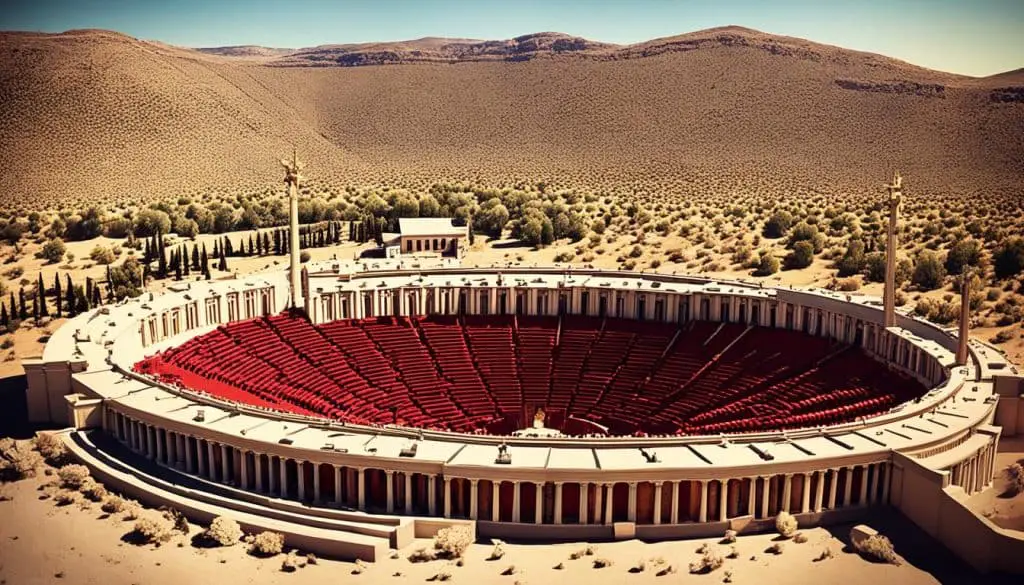
However, the tabernacle and its offerings were merely a shadow of the greater reality to come. The author of Hebrews goes on to contrast the temporary nature of the tabernacle with the eternal significance of Jesus’s ministry. Through his sacrificial death and resurrection, Jesus ushered in a new covenant, rendering the old tabernacle system obsolete.
The superiority of Jesus’s ministry is highlighted in Hebrews 9:11-12, which states, “But when Christ came as high priest of the good things that are now already here, he went through the greater and more perfect tabernacle that is not made with human hands, that is to say, is not a part of this creation. He did not enter by means of the blood of goats and calves; but he entered the Most Holy Place once for all by his own blood, thus obtaining eternal redemption.”
This passage emphasizes the superiority of Jesus’s ministry over the tabernacle and its sacrifices. Jesus, as the perfect high priest, entered the true sanctuary of heaven, not with the blood of animals, but with his own blood, securing eternal redemption for all who believe in him.
“For Christ did not enter a sanctuary made with human hands that was only a copy of the true one; he entered heaven itself, now to appear for us in God’s presence.”
Hebrews 9:24
The comparison between the tabernacle and Jesus’s ministry serves to highlight the surpassing greatness of Jesus. While the tabernacle was a symbolic representation of God’s presence among his people, Jesus is the embodiment of God’s presence. Through his ministry, Jesus reveals the true nature of God and provides direct access to God’s presence for all who believe in him.
By appearing in God’s presence on our behalf, Jesus fulfills the purpose of the tabernacle and brings us into a deeper, more intimate relationship with God. The tabernacle was a foreshadowing of the greater reality found in Jesus, who is the ultimate mediator between God and humanity.
Through his ministry, Jesus offers forgiveness, reconciliation, and the hope of eternal life. The tabernacle and its services were temporary and limited, while Jesus’s ministry is eternal and infinitely superior.
The ministry of Jesus transcends the physical confines of the tabernacle and invites us into a personal encounter with God himself. It is through Jesus that we can experience true worship, communion with God, and find our ultimate fulfillment. The tabernacle was a place where God’s presence dwelled momentarily, but in Jesus, God’s presence dwells permanently and intimately within our hearts.
Jesus Tabernacling Among Us (John 1:14)
In the Gospel of John, we encounter a profound revelation of Jesus’s incarnation. John 1:14 beautifully encapsulates this truth, stating, “And the Word became flesh and dwelt among us.” This verse, when examined closely, unveils the significance of Jesus tabernacling among humanity, with the word “dwelt” holding a deeper meaning – it can be translated as “tabernacled.”
By using the word “tabernacled,” John intentionally evokes the imagery of the tabernacle in the Old Testament, which served as God’s dwelling place among His people. In pitching His tent among us, Jesus stepped down from His heavenly glory and assumed human form to dwell in our midst, just as the tabernacle symbolized God’s presence dwelling among the Israelites.
“And the Word became flesh and dwelt among us.”
This concept of Jesus tabernacling among us carries immense significance. Just as God’s presence filled the tabernacle, Jesus brought the presence of God into our world. He manifested the glory and grace of God through His words, actions, and ultimately, through His sacrificial death on the cross.
By tabernacling among us, Jesus demonstrated His desire to intimately connect with humanity, to experience our joys, sorrows, and challenges. He became Emmanuel, “God with us,” the ultimate representation of God’s love and compassion.
Through His earthly ministry, Jesus not only revealed the Father’s heart but also paved the way for us to encounter and experience the presence of God in a profound and personal manner. He opened the door for us to have a direct relationship with God, no longer confined to a physical tabernacle, but rather through faith and the indwelling of the Holy Spirit.
As we reflect on John 1:14, let us marvel at the extraordinary truth of Jesus tabernacling among us. His incarnation represents the culmination of God’s plan to restore humanity into a deep and intimate relationship with Him. Through His life, death, and resurrection, Jesus invites us into the presence of God, where we find forgiveness, redemption, and eternal life.
Desire for a Dwelling Place for God’s Presence (Matthew 17:4)
During the transfiguration, Peter suggests building three tabernacles for Jesus, Moses, and Elijah. This reflects the desire to create a dwelling place for God’s presence, reminiscent of the tabernacle’s purpose.
“Lord, it is good for us to be here. If you wish, I will put up three shelters—one for you, one for Moses, and one for Elijah.”
Matthew 17:4 emphasizes the longing to establish a place where God’s presence can abide. Just as the tabernacle served as a tangible representation of God dwelling among His people, Peter’s proposal to construct tabernacles for Jesus, Moses, and Elijah expresses a deep desire to create a space where God’s presence can be tangibly experienced and worshipped.
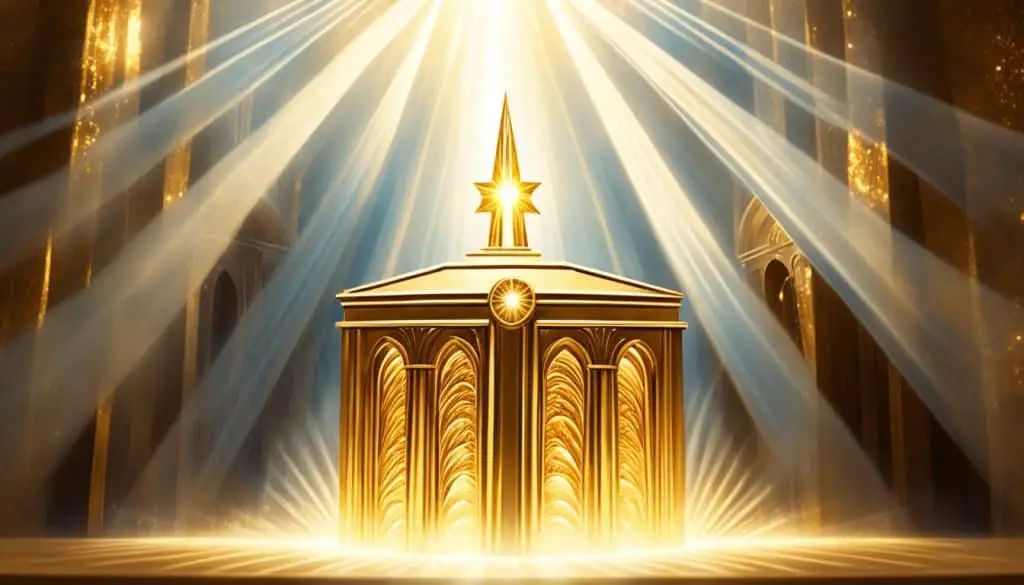
| Building Tabernacles | Motivation |
|---|---|
| Jesus | Recognizing His divine nature and desiring to honor His presence. |
| Moses | Recalling the times when God’s glory dwelled in the tabernacle during their wilderness journey. |
| Elijah | Longing for a revival of God’s manifest presence as seen in the time of the prophets. |
Together, Peter’s proposal and Matthew 17:4 highlight the profound human longing for a space where God’s presence can dwell. It underscores the significance of the tabernacle in fulfilling this desire throughout history and the continued significance of seeking a dwelling place for God’s presence today.
The Tabernacle in the Wilderness (Acts 7:44)
Stephen, in his speech, references our ancestors having the tabernacle in the wilderness. This serves to connect the history of Israel’s worship in the tabernacle with the ongoing story of God’s presence.
“Our ancestors had the tabernacle of the covenant law with them in the wilderness. It had been made as God directed Moses, according to the pattern he had seen.”
Acts 7:44 highlights the significance of the tabernacle in the wilderness as a physical representation of God’s presence among His chosen people. As directed by God, Moses constructed the tabernacle based on a heavenly pattern he had seen, making it a sacred place where Israel’s worship and sacrifices took place.
By mentioning the tabernacle in the wilderness, Stephen emphasizes the continuity of God’s presence throughout Israel’s history. The tabernacle served as a tangible symbol of God dwelling among His people, guiding and protecting them on their journey.
The tabernacle’s establishment in the wilderness marked a key moment in Israel’s relationship with God, as it provided a central place for their worship and served as a dwelling place for His presence. This ongoing story of God’s presence continued even after the tabernacle gave way to the temple in Jerusalem in later years.
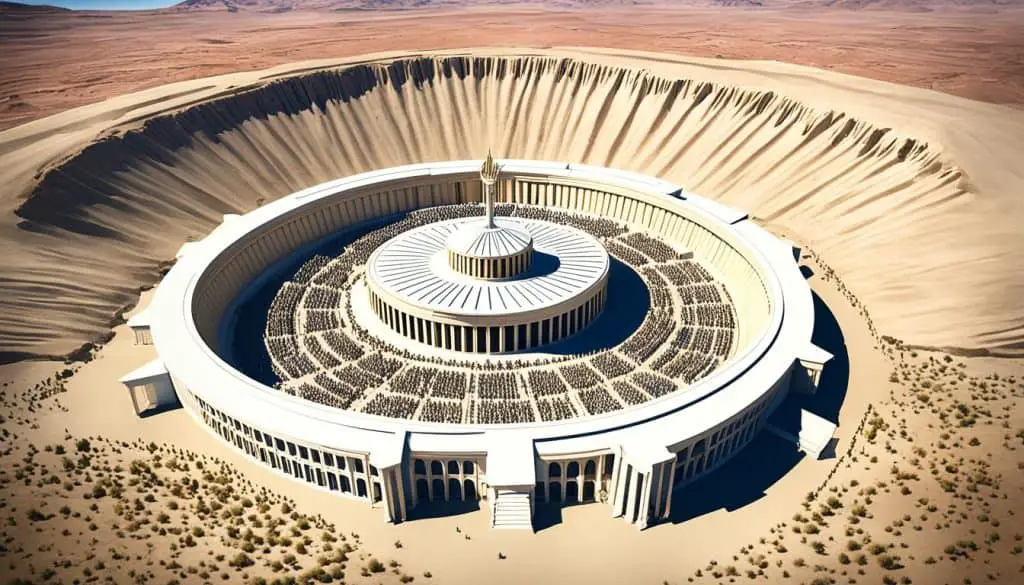
| Tabernacle in the Wilderness | Key Points |
|---|---|
| Significance | Symbol of God’s presence among the Israelites |
| Construction | Based on a heavenly pattern revealed to Moses |
| Worship | Place for sacrifices and offerings |
| Continuity | Connected the past, present, and future of God’s presence |
Symbolic Altar and Spiritual Sacrifices (Hebrews 13:10)
In Hebrews 13:10, the author mentions the altar from which believers partake, symbolizing the tabernacle’s altar. This verse highlights the profound spiritual truth that the sacrifices made through Jesus are not confined to a physical altar but are instead symbolic and spiritual in nature. Through the sacrificial work of Jesus, believers are offered the opportunity to present their own spiritual sacrifices.
The symbolic altar represents the tabernacle’s altar, which played a crucial role in the Old Testament sacrificial system. It was the place where animal sacrifices were offered as a means of atonement for the sins of the people. However, with the coming of Jesus, the need for these physical sacrifices was fulfilled.
Just as the tabernacle’s altar served as a point of connection between God and His people, the altar mentioned in Hebrews 13:10 serves as a reminder that believers can now approach God directly through Jesus. This spiritual altar represents the access and communion that believers have with God through faith in Jesus Christ.
Furthermore, the mention of “spiritual sacrifices” in this verse emphasizes that the sacrifices made through Jesus are not physical offerings, but rather offerings of the heart and spirit. Believers are called to offer their lives, worship, service, and obedience as spiritual sacrifices to God. These sacrifices are a response to the grace and love shown through Jesus’ sacrifice on the cross.
“Therefore, let us continually offer the sacrifice of praise to God, that is, the fruit of our lips, giving thanks to His name.” – Hebrews 13:15
As believers, we are called to present our lives as living sacrifices, devoted to God and His purposes. This involves offering ourselves wholly to Him, surrendering our desires, ambitions, and selfishness. Our sacrifices are not to earn salvation or favor with God, but rather an expression of our love and gratitude for what He has done for us through Jesus.
The symbolism of the altar and the concept of spiritual sacrifices in Hebrews 13:10 echo the purpose of the tabernacle’s altar and point to the redemptive work of Jesus. Through Him, we have access to God’s presence and can offer our whole lives as a spiritual sacrifice, living in obedience and worship.
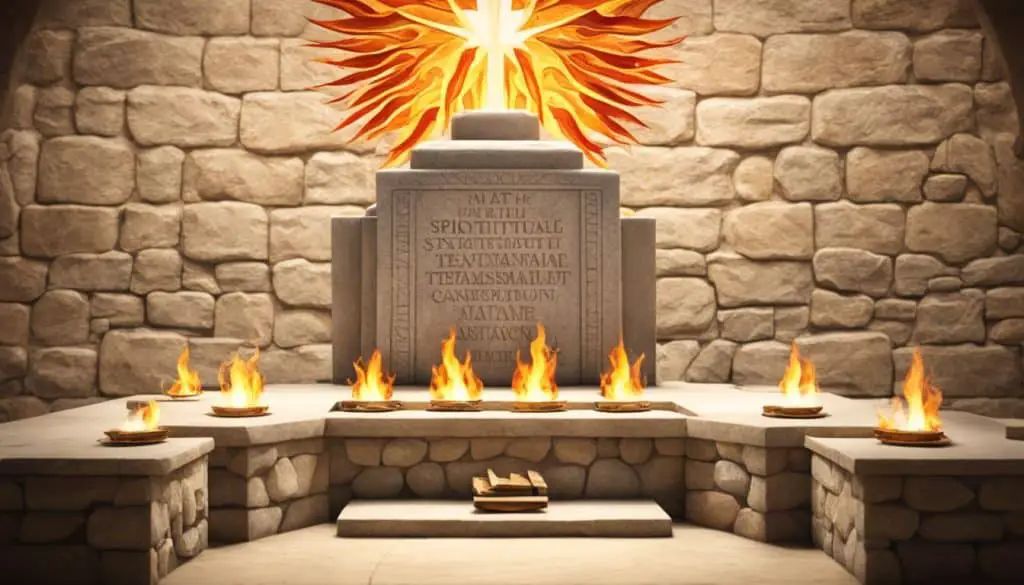
The Heavenly Tabernacle (Revelation 15:5)
In Revelation 15:5, the divine vision of the heavenly tabernacle, also known as the “tabernacle of the testimony,” is revealed. This sacred imagery holds profound significance as it represents the eternal dwelling of God among his people. Just as the tabernacle in the Old Testament served as a place of worship and God’s presence, the heavenly tabernacle signifies the fulfillment of this symbolism, where God’s eternal dwelling is established among his beloved.
The heavenly tabernacle stands as a testament to God’s everlasting presence and his desire to be with his people for all eternity. It is a glimpse into the eternal reality where God’s glory radiates and his people find refuge and communion with the Almighty.
This divine revelation, encapsulated in Revelation 15:5, offers a glimpse into the significance of the tabernacle of the testimony and its eternal dwelling of God among his people. It underscores the profound truth that God’s desire to dwell with humanity is not confined to the earthly realm but extends into eternity, where the fullness of his glory and presence will be experienced.

As we meditate on this heavenly vision, we are reminded of the deep connection between the earthly tabernacle and the eternal dwelling of God. The tabernacle in the Old Testament was a foreshadowing of the ultimate reality that would be fulfilled in the heavenly tabernacle—a place where God’s people will forever dwell in his presence.
Let us embrace the significance of the heavenly tabernacle and rejoice in the assurance that God’s eternal dwelling among his people is not merely a distant hope but a glorious reality to come.
The Greater and More Perfect Sacrifice (Hebrews 9:23-24)
In Hebrews 9:23-24, we learn about the significance of Christ’s sacrifice as the greater and more perfect offering compared to the sacrifices made in the earthly tabernacle. The offerings presented in the tabernacle were mere shadows of the heavenly things that were to come.
“It was therefore necessary that the copies of the things in the heavens should be purified with these, but the heavenly things themselves with better sacrifices than these.”
“For Christ has not entered the holy places made with hands, which are copies of the true, but into heaven itself, now to appear in the presence of God for us.”
These verses highlight the essentiality of Christ’s sacrifice, which surpasses the earthly tabernacle’s offerings. The sacrifices made in the tabernacle, such as the blood of animals, served as symbolic representations of atonement and forgiveness. However, they were temporary and imperfect, incapable of permanently cleansing sins.

By contrast, Jesus’s sacrifice on the cross was greater and more perfect. It was the ultimate sacrifice, offering eternal redemption for all who believe in Him. His sacrifice fulfilled the typology of the tabernacle, eclipsing the shadows with the reality of the heavenly things.
| Offerings in the Earthly Tabernacle | The Greater and More Perfect Sacrifice of Christ |
|---|---|
| Blood of animals | His precious blood |
| Temporary cleansing | Eternal redemption |
| Symbolic representations | Ultimate reality |
| Repeated sacrifices | One sacrifice for all |
Through His sacrificial death, Jesus accomplished what the earthly tabernacle could not. His sacrifice opened the way for believers to approach God’s presence with boldness and experience complete forgiveness and reconciliation.
Let us marvel at the immeasurable gift of Christ’s sacrifice, which goes beyond the limitations of the earthly tabernacle and reveals the glorious reality of God’s love and grace.
What Are Some Biblical References to the Tabernacle in the New Testament?
The New Testament has several connections between tabernacle and Jesus. In John 1:14, it is mentioned that Jesus “dwelt among us,” mirroring the presence of God in the tabernacle. Hebrews 9:11 describes Jesus as the high priest of the “greater and more perfect tabernacle.
The Fulfillment of God Dwelling With Man (Revelation 21:3)
Revelation 21:3 unveils the long-awaited fulfillment of God’s desire to dwell with humanity. This profound revelation echoes the very purpose of the tabernacle, which served as a physical manifestation of God’s presence among his people in the Old Testament.
In the new Jerusalem, God’s dwelling place is no longer confined to a portable tent or a physical structure. It becomes a reality where he will dwell with his people eternally. This signifies a remarkable progression from the tabernacle to a more intimate and everlasting connection between God and humanity.
The tabernacle’s purpose was to bridge the gap between a holy God and sinful humanity. Through the sacrificial system and the High Priest’s intercession, the people of Israel experienced a temporary dwelling of God’s presence. However, in the new Jerusalem, this connection becomes permanent and unbroken.
Imagine the joy and fulfillment of experiencing the dwelling of God with man in its fullness. In the new Jerusalem, there will be no need for symbols or physical structures because God himself will be present, illuminating every corner with his glory. It will be a place of perfect communion, where the tabernacle’s purpose finds its ultimate realization.

